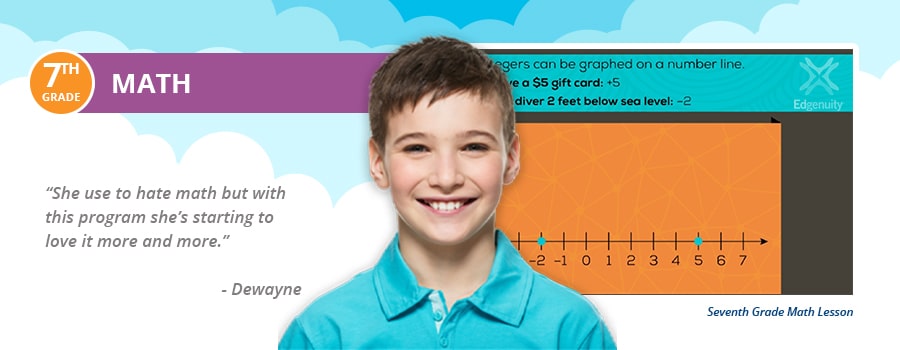7th Grade Homeschool Math Curriculum
We at Time4Learning view ourselves as partners with parents in ensuring that students finish middle school with the skills they need to be successful in high school level courses. For mathematics, in particular, that means providing a standards-based program that is focused on the major math concepts while using many different types of multimedia tools to engage students and inspire a greater interest in mathematics.
What Do 7th Graders Learn in Math?
A seventh grade math curriculum should cover all the math strands, not just arithmetic. The major math strands for seventh grade curriculum are:
- Number sense and operations
- Algebra
- Geometry and spatial sense
- Ratio and proportional relationships
- Data analysis
- Probability
The ideal math curriculum for 7th grade should be based on these standards while engaging students with fun and varied activities.
Learn more about Time4Learning’s seventh grade math lessons below.
7th Grade Math Goals and Objectives
A comprehensive 7th grade math curriculum will ensure that students are covering each of these learning targets:
- Develop an understanding of operations with rational numbers.
- Accurately represent rational numbers with decimals.
- Analyze proportional relationships and use them to solve real-world and mathematical problems.
- Draw, construct, and describe geometrical figures and describe the relationships between them.
- Solve real-world and mathematical problems involving angle measure, area, and volume.
- Extend use of the four basic arithmetic operations on whole numbers, fractions, mixed numbers, and decimals.
- Interpret and analyze data presented in a variety of forms.
- Use properties of operations to generate equivalent equations.
- Solve real-world and mathematical problems using numerical and algebraic expressions, equations, and inequalities.
Time4Learning’s 7th Grade Math Lesson Plans
Express whole numbers using exponents.
Express numbers greater than one using scientific notation and vice versa.
Write numbers in word, standard, expanded, and scientific notation.
Apply order of operations to simplify numerical expressions.
Use estimation to solve problems with whole numbers.
Knows relationships and can convert between fractions, decimals, and percents.
Use estimation to solve problems with whole numbers, fractions, decimals, and percents.
Identify numbers as prime or composite.
Find the prime factorization of whole numbers.
Find the greatest common factor and least common multiple of two numbers.
Identify and use ratios and rates.
Recognize relationships between ratios, proportions, and percents.
Use tables to solve problems with proportions.
Use constant ratios to solve problems.
Solve real world problems involving discounts and mark ups.
Solve real world problems involving simple interest.
Identify proportional relationships in scale drawings.
Determine whether a relationship is proportional by testing for equivalent ratios in a table.
Determine proportional relationships from a graph.
Identify the constant of proportionality.
Identify the constant of proportionality from tables and graphs.
Write equations for proportional relationships.
Explain the meaning of points on a graph.
Describe situations in which opposite quantities combine to make zero.
Add rational numbers on number lines.
Model distance on a number line.
Subtract rational numbers on a number line.
Apply distances using absolute values.
Identify pairs of additive and multiplicative inverses.
Add and subtract with positive and negative rational numbers.
Interpret sums of rational numbers.
Multiply and divide with positive and negative rational numbers.
Solve real world problems with fractions, decimals, and integers.
Apply properties of operations as strategies to add and subtract.
Multiply signed rational numbers.
Interpret products of rational numbers.
Interpret quotients of rational numbers.
Apply properties to multiply and divide rational numbers.
Simplify and evaluate algebraic expressions using integers.
Generalize properties of real numbers to expressions and equations.
Translate simple one variable word expressions and equations into corresponding symbolic expressions and equations.
Use algebraic expressions to generalize a pattern.
Simplify algebraic expressions with one variable by combining like terms.
Substitute values for variables in an equation to verify whether the equation is true.
Solve one-step linear equations.
Solve two-step linear equations.
Perform operations on linear expressions.
Write an expression in different forms to represent a situation.
Solve multi-step problems with rational numbers.
Solve multi-step problems by converting rational numbers between forms.
Solve equations of the form px + q = r.
Solve equations of the form p(x + q) = r.
Compare algebraic and arithmetic solutions.
Write and solve two-step inequalities.
Graph and interpret solutions of inequalities.
Identify and classify triangles.
Find the measure of an interior or exterior angle using an angle relationship.
Solve angle measurement problems for triangles.
Demonstrate or identify the Pythagorean relationship using models or diagrams.
Given two sides of a right triangle, find the length of a third side.
Find the perimeter and area of two-dimensional figures.
Find the circumference and area of circles.
Identify and use symbolic notation to denote lines (intersecting, skew, parallel, perpendicular).
Find the measure of an angle using a protractor or angle relationship.
Describe and apply parallelism and perpendicularity in real world contexts.
Compare and describe attributes of regular and nonregular convex polygons (parallelograms, trapezoids, pentagons, hexagons, and octagons).
Find the measure of the interior angles of a regular polygon.
Find the measure of an angle using a protractor or angle relationship (corresponding, complementary, and supplementary).
Identify attributes of a figure congruent or similar to a given figure.
Construct parallelograms.
Construct triangles using given angles. (with a protractor and ruler)
Identify attributes properties of three-dimensional figures.
Calculate the volume of prisms and cylinders.
Calculate the surface area of prisms and cylinders.
Find the area of composite two-dimensional figures.
Measure length, weight, capacity, and volume using customary or metric units.
Know the relationship between mass and volume and solve problems.
Compare units within each system.
Develop and apply d=rt to solve problems for rate, time, and distance.
Estimate measurements of length, weight, volume or capacity.
Perform operations on measurements within each system.
Solve problems involving conversions within the same system.
Identify and plot ordered pairs in four quadrants and along the axes.
Identify quadrants and characteristics of points.
Recognize correspondence between a set of points in a table and a set of points plotted in a coordinate plane.
Represent real-world data using graphs.
Recognize whether a set of points given in a table or a graph represents a function.
Determine that the graph of a linear equation is a straight line.
Identify points on graphs of linear functions to answer questions about real world situations.
Obtain results using manipulatives and explain the difference between theoretical and experimental results.
Calculate probabilities of independent and dependent events.
Compute odds of simple events.
Interpret and analyze data representations including circle, line, bar, histogram, stem-and-leaf, and box-and-whisker graphs.
Calculate the range, mean, median, and mode of data from a table, chart, or graph.
Apply and analyze measures of central tendency (mean, median, and mode).
Use technology to analyze and create graphs given a data set.
Why Choose T4L Seventh Grade Math Homeschool Curriculum?
Time4Learning’s standards-based curriculum covers all of the 7th grade math learning targets listed above, plus many, many more. It is designed to help students develop conceptual understanding of math while improving their ability to apply mathematics to solve problems. This approach prepares students for the study of more advanced mathematics in later years.
Learn more about our online seventh grade curriculum, designed to help your child learn and master their fundamental concepts.







